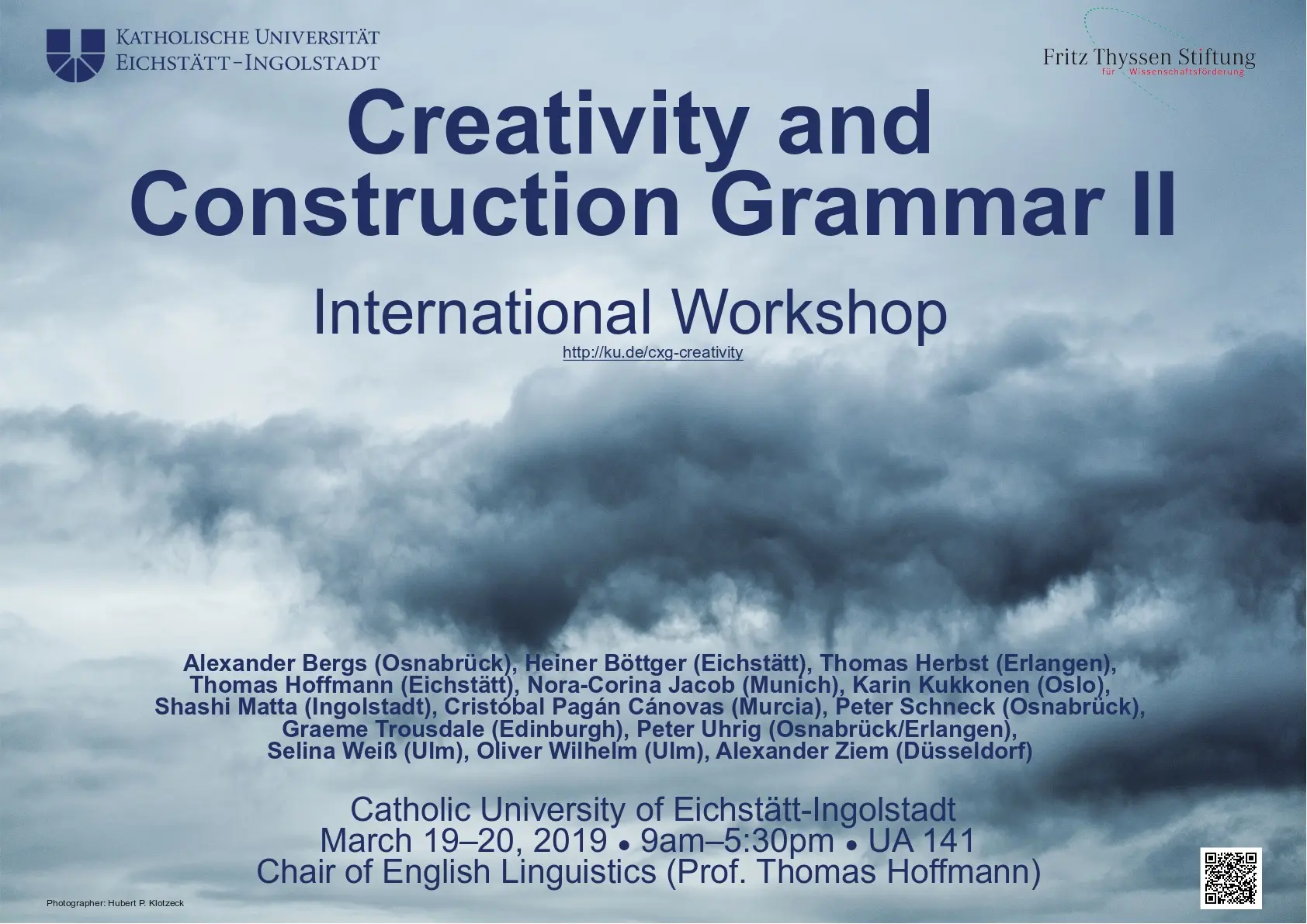Internationaler Workshop "Creativity and Construction Grammar" II (2019)

Allgemeine Informationen
Katholische Universität Eichstätt-Ingolstadt
- 19.-20. März 2019 (Sektempfang am 18. März um 18:30)
- 9:00–17:30
- UA-141
Konferenzprogramm
Hier finden Sie das Konferenzprogramm.
Referenten
Alexander Bergs (Osnabrück), Heiner Böttger (Eichstätt), Thomas Herbst (Erlangen), Thomas Hoffmann (Eichstätt), Nora-Carina Jacob (München), Karin Kukkonen (Oslo), Shashi Matta (Ingolstadt), Cristóbal Pagán Cánovas (Múrcia), Peter Schneck (Osnabrück), Graeme Trousdale (Edinburgh), Peter Uhrig (Osnabrück/Erlangen), Selina Weiß (Ulm), Oliver Wilhelm (Ulm), Alexander Ziem (Düsseldorf)
Abstract
"Creativity" is a crucial evolutionary adaptation capability that allows humans to think original thoughts, to find solutions to problems never encountered before and to fundamentally change the way we live. The once original idea to equip vehicles with motor engines, for instance, has radically changed our mobility behaviour and, consequently, our perception of time and space. The smartphone, again, has had an immense impact on how we communicate with each other and on how we access information. Going back even further in history, the invention of writing systems to represent spoken language has fundamentally increased our cultural ability for transmitting and spreading ideas and knowledge.
A previous workshop (the results of which were published in Thomas Hoffmann, ed. 2018. Linguistic Creativity. Special Issue of Zeitschrift für Anglistik und Amerikanistik 66,3) already explored the following issues of verbal creativity from a Construction Grammar perspective: How F- and E-creativity have to be interpreted from a Construction Grammar perspective (Bergs 2018; Hoffmann 2018; Uhrig 2018).
- The different processes leading to linguistic innovations (such as, e.g., errors and mistakes, extravagance, language contact, priming as well as intentional linguistic mechanisms such as snowcloning, coercion and aberrancy; Bergs 2018; de Smet 2018) and the various effects these have on the mental network of constructions.
- The incremental and gradual nature of linguistic creativity (Herbst 2018, Uhrig 2018).
- Computational linguistic implementations to model F- and E-creativity within Construction Grammar (van Eeck and Beuls 2018)
- The similarities and differences of creativity in music and language (Trousdale 2018)
- A critical assessment of all these constructionist approaches from a literature studies perspective (Schneck 2018).
The major goals of the workshop are to explore the following questions
- Theoretical: How are the cognitive processes underlying human innovation and creativity explained in the various scientific fields?
- Methodological: How do the different scientific fields measure / test creative behavior?
- More generally: Which theoretical and methodological insights from other scientific fields can be fruitfully incorporated into Construction Grammar approaches to linguistic innovation and creativity? And, on the other hand, can these other fields, perhaps, benefit from Construction Grammar insights into verbal creativity?